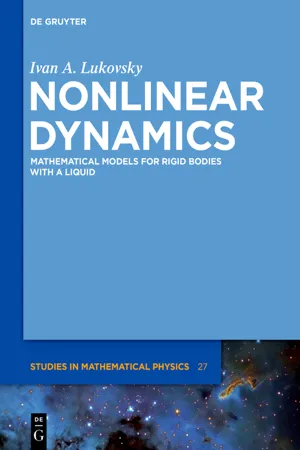
- 410 pages
- English
- ePUB (mobile friendly)
- Available on iOS & Android
Nonlinear Dynamics
About This Book
This book is devoted to analytically approximate methods in the nonlinear dynamics of a rigid body with cavities (containers) partly filled by a liquid. The methods are normally based on the Bateman-Luke variational formalism combined with perturbation theory. The derived approximate equations of spatial motions of the body-liquid mechanical system (these equations are called mathematical models in the title) take the form of a finite-dimensional system of nonlinear ordinary differential equations coupling quasi-velocities of the rigid body motions and generalized coordinates responsible for displacements of the natural sloshing modes. Algorithms for computing the hydrodynamic coefficients in the approximate mathematical models are proposed. Numerical values of these coefficients are listed for some tank shapes and liquid fillings. The mathematical models are also derived for the contained liquid characterized by the Newton-type dissipation. Formulas for hydrodynamic force and moment are derived in terms of the solid body quasi-velocities and the sloshing-related generalized coordinates. For prescribed harmonic excitations of upright circular (annular) cylindrical and/or conical tanks, the steady-state sloshing regimes are theoretically classified; the results are compared with known experimental data.
The book can be useful for both experienced and early-stage mechanicians, applied mathematicians and engineers interested in (semi-)analytical approaches to the "fluid-structure" interaction problems, their fundamental mathematical background as well as in modeling the dynamics of complex mechanical systems containing a rigid tank partly filled by a liquid.
Frequently asked questions
Information
Chapter 1
Governing equations and boundary conditions in the dynamics of a bounded volume of liquid
1.1 Conservation laws. Governing equations






Table of contents
- De Gruyter Studies in Mathematical Physics 27
- Titel
- Impressum
- Foreword to English Edition
- Foreword to Russian Edition
- Inhaltsverzeichnis
- Introduction
- Chapter 1 - Governing equations and boundary conditions in the dynamics of a bounded volume of liquid
- Chapter 2 - Direct methods in the nonlinear problems of the dynamics of bodies containing liquids
- Chapter 3 - Hydrodynamic theory of motions of the ships transporting liquids
- Chapter 4 - Nonlinear differential equations of space motions of a rigid body containing an upright cylindrical cavity partially filled with liquid
- Chapter 5 - Nonlinear modal equations for noncylindical axisymmetric tanks
- Chapter 6 - Derivation of the nonlinear equations of space motions of the body–liquid system by the method of perturbation theory
- Chapter 7 - Equivalent mechanical systems in the dynamics of a rigid body with liquid
- Chapter 8 - Forced finite-amplitude liquid sloshing in moving vessels
- Bibliography
- Index
- De Gruyter Studies in Mathematical Physics